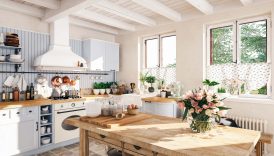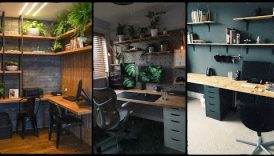The Ultimate Guide to Choosing the Perfect Color Palette for Your Home

Understanding Color Theory for Your Home
Importance of Color Psychology
When it comes to home decor, understanding color theory is essential. Color psychology plays a crucial role in how we feel and behave in a space. For example, a soothing palette can transform a room into a relaxing retreat, while vibrant colors may inject energy into a workspace. Consider this: when Sarah, a close friend, redecorated her living room, she opted for warm blues and soft whites. The result? A serene atmosphere that felt welcoming and peaceful. Studies show that colors like blue and green can lower stress levels and promote tranquility, making them ideal choices for bedrooms or lounging areas. On the other hand, color choices can also impact energy levels and productivity. A pop of yellow in a kitchen can evoke warmth and happiness, while reds and oranges stimulate enthusiasm. This is why pairing colors mindfully, based on their psychological effects, is vital.
- The Ultimate Guide to Choosing the Perfect Color Palette for Your Home
- Understanding Color Theory for Your Home
- Importance of Color Psychology
- How to Create Harmony with Color Palettes
- Choosing the Right Colors for Different Rooms
- Selecting Calming Tones for Bedrooms
- Energizing Options for Home Office Spaces
- Exploring Different Color Schemes
- Monochromatic Palettes
- Complementary Color Combinations
- Factors to Consider When Selecting a Color Palette
- Natural Lighting and Room Size
- Existing Furniture and Decor Styles
- Utilizing Color Tools and Resources
- Online Color Palette Generators
- Inspiration from Interior Design Magazines
How to Create Harmony with Color Palettes
Creating a harmonious space through color palettes involves more than matching hues. Here are several tips to get you started:
- Start with a Base Color: Choose a predominant color that reflects your desired mood.
- Add Accent Colors: Select two to three complementary colors to add depth. For instance, if your base color is a soft gray, paired with mustard yellow gives a modern, cheerful vibe.
- Consider the 60-30-10 Rule: This classic guideline suggests using 60% of your main color, 30% of a secondary color, and 10% for an accent. This balance helps to maintain visual interest.
- Experiment with Textures: Different textures can change how colors appear. A matte finish might look muted, while a glossy paint might enhance brightness.
- Use Color Samples: Testing out paint samples on your walls allows you to see how they interact with lighting throughout the day.
By being intentional with your color choices and understanding their effects, creating a cohesive and inviting atmosphere in your home becomes an achievable goal. Remember, your space should reflect your individuality, so choose colors that speak to you!
Choosing the Right Colors for Different Rooms
Selecting Calming Tones for Bedrooms
When it comes to creating a restful sanctuary, the color you choose for your bedroom can make all the difference. Soft, calming tones evoke feelings of peace and relaxation, setting the perfect backdrop for restful sleep. For instance, consider Lisa, who transformed her once drab bedroom into a serene oasis. She selected a palette of soft greens and muted blues, which not only brightened the space but also created a refreshing atmosphere. Research suggests these colors are linked to tranquility, making them popular choices for bedrooms. Here are some calming colors and their effects:
- Soft Blues: Associated with quietness, they can lower blood pressure and create a restful environment.
- Gentle Greens: Instill a sense of renewal and are reminiscent of nature, promoting a balanced mood.
- Lavender: Offers a touch of elegance while still being soothing; ideal for creating a peaceful space.
To enhance the calming effect, consider using lighter shades that reflect natural light, and incorporate natural textures like wood or cotton to complement your color palette.
Energizing Options for Home Office Spaces
Conversely, a home office should be vibrant and stimulating to boost energy levels and productivity. The right color choices can ignite creativity and focus during those long work hours. Take Mark, for example; he painted his home office a lively shade of orange with accents of teal. This combination energized him, making mundane tasks feel more dynamic. Research supports that warm colors like orange and yellow evoke feelings of enthusiasm and motivation. Here are some energizing colors to consider:
- Bright Yellows: Encourage optimism and clear thinking, perfect for brainstorming sessions.
- Vibrant Oranges: Stimulate creativity and can foster a fun atmosphere while working.
- Bold Reds: Attention-grabbing, they can generate excitement and encourage dynamic discussions.
Additionally, blending these energizing hues with neutral colors such as grays or whites can help keep the space feeling professional yet vibrant. By choosing colors that cater to the desired function of each room, you can create an environment that not only looks great but also enhances your daily activities!
Exploring Different Color Schemes
Monochromatic Palettes
One of the most sophisticated approaches to color selection is using a monochromatic palette. This scheme revolves around varying shades and tints of a single color, creating a serene and cohesive look throughout a room. Take Emma’s cozy reading nook, for instance. She decided to decorate using different shades of blue, from the softest powder blue on the walls to deep navy in the pillows and throws. The result? A soothing space that feels unified and elegant. Here’s why monochromatic schemes work effectively:
- Ease of Coordination: Since you’re working with one color family, coordinating pieces becomes simpler.
- Sense of Space: Variations in lightness and darkness can give the illusion of depth, making a room feel more expansive.
- Calm Aesthetic: This palette can convey tranquility, making it ideal for spaces intended for relaxation, like bedrooms and bathrooms.
To make a monochromatic palette pop, add texture. Mixing fabrics like a soft velvet chair with a knotted wool blanket creates visual interest without overwhelming the senses.
Complementary Color Combinations
On the other hand, complementary color combinations offer a vibrant contrast that can energize a space. These color schemes involve pairing colors that are opposite each other on the color wheel, resulting in a dynamic and eye-catching effect. For example, Tom recently painted his kitchen with a fresh green and paired it with bold red accents in the decor. The contrasting colors instantly brought life into the space, making it feel inviting and exciting during gatherings. Here are some popular complementary color pairings:
- Blue and Orange: A playful combination that stimulates creativity—perfect for a living room or art studio.
- Yellow and Purple: This pairing adds a regal touch, ideal for dining areas or accent walls.
- Green and Red: Often associated with the holidays, this combo can also work year-round when used thoughtfully.
To balance the vibrancy, keep larger surfaces neutral and use complementary colors for smaller accents to avoid overwhelming the space. Exploring different color schemes—whether monotonous or contrasting—can lead to stunning interiors that reflect your personality beautifully. Consider experimenting with these palettes in your own home to find what resonates best!
Factors to Consider When Selecting a Color Palette
Natural Lighting and Room Size
Choosing the right color palette for your home doesn’t solely rely on personal preference; it also depends significantly on natural lighting and room size. These factors can dramatically affect how colors are perceived and how they interact within a space. Consider the experience of Jordan, who recently painted his compact apartment living room. He used a deep navy blue, which, while beautiful, made the space feel even smaller. After swapping it for a light cream shade, the room instantly felt airy and open. This illustrates how lighter colors can create a sense of space, especially in smaller rooms. Here are some tips to keep in mind:
- Evaluate the Lighting: Rooms with plenty of natural light can handle darker, richer colors without feeling overly cramped. Conversely, dimly lit rooms may benefit from lighter, brighter shades to reflect light and seem larger.
- Test Before Committing: Paint swatches can appear different at various times of the day. It’s wise to try samples on the wall and observe how they look in different lighting conditions.
- Room Dimensions: Larger spaces can embrace bolder, deeper hues, while smaller rooms often benefit from soft, muted colors to avoid becoming overwhelming.
Existing Furniture and Decor Styles
Another critical factor in selecting a color palette is your existing furniture and decor styles. It’s essential to create a cohesive look that ties different elements together seamlessly. Take Rachel’s home, for example. When she chose a bright yellow for her home office, it clashed with her dark wood furniture. A quick refresh to a soft gray kept the space looking fresh and modern, complementing the rich tones of her existing decor. Here are some strategies to consider:
- Complement, Don’t Compete: Your color palette should enhance your furniture and decor, not overshadow it. Think about color wheel counterparts to find harmonious combinations.
- Consider the Style: For contemporary or minimalist styles, a muted palette may be best. In contrast, eclectic or bohemian designs can handle brighter, more varied colors.
- Create Zones: If a space serves multiple functions (like a living area and dining area), use color to define these zones while still ensuring they work cohesively together.
By paying attention to natural light, room size, and existing decor, you can craft a color palette that not only reflects your style but also enhances the functionality and beauty of your space. Experimentation is key, and soon you’ll find the perfect balance for your home!
Utilizing Color Tools and Resources
Online Color Palette Generators
In the digital age, color palette generators offer a fantastic way to explore and curate colors that capture your vision. These tools can take the guesswork out of selecting hues that harmonize beautifully together. My friend Max discovered this when he utilized an online generator while redecorating his home office. He began with a pair of colors that he loved—deep teal and soft coral. Using a generator, he was able to find complementary shades that not only enhanced those two colors but also helped avoid overwhelming the space. The result was nothing short of stunning! Here’s how you can make the most of online color palette generators:
- Experiment Freely: Inputs like a primary color or image can yield hundreds of combinations, which can be filtered based on your preferences.
- Save and Share: Most tools allow you to save your favorite palettes, making it easy to reference them when shopping for paint or decor.
- Visualize with Mockups: Some generators let you see how colors look together in virtual rooms, helping you visualize your design before making any purchases.
Some popular generators include Adobe Color, Coolors, and Canva Color Palette Generator, which can guide you in creating a cohesive look with minimal effort.
Inspiration from Interior Design Magazines
In addition to digital tools, traditional resources like interior design magazines remain a treasure trove of inspiration. They provide real-life applications of color schemes and trends, which can spark creativity. For example, when Mia redecorated her living room, she flipped through an interior design magazine that highlighted a beautiful combination of muted pastels. She was captivated by how those colors transformed various rooms, from calm sitting spaces to cheerful dining areas. It encouraged her to step out of her comfort zone and embrace some softer tones in her decor. Here’s how to effectively utilize magazines for color inspiration:
- Create a Vision Board: Tear out or save pages that resonate with your style. Group them by color or theme to identify patterns and preferences.
- Follow Seasonal Trends: Magazines often showcase seasonal color trends, which can help you stay updated and contemporize your home.
- Adapt Styles: Use magazine ideas as a starting point to adapt designs in a way that aligns with your tastes and existing furnishings.
By combining the power of online color generators with the timeless inspiration of interior design magazines, you’ll be well-equipped to create a beautiful, cohesive color palette that enhances your home’s aesthetic and functionality. Happy decorating!





